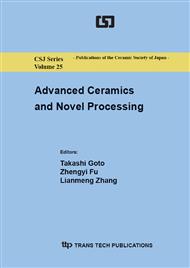p.247
p.252
p.258
p.263
p.270
p.275
p.280
p.286
p.291
Effect of Subsurface Deformation on Sliding Wear Behavior of Ti-29Nb-13Ta-4.6Zr Alloys for Biomedical Applications
Abstract:
The wear mechanisms of conventional Ti–6Al–4V extra-low interstitial (Ti64) and the new Ti–29Nb–13Ta–4.6Zr (TNTZ) were studied to investigate the wear properties of Ti64/TNTZ for application in spinal fixation devices. Ti64 and TNTZ balls and discs were first prepared as wear-test specimens. A ball-on-disc frictional wear-testing machine was used in air to perform the frictional wear tests of the Ti64 and TNTZ discs mated against Ti64 and TNTZ balls. The wear mechanisms were investigated using a scanning electron microscopy to analyze the worn surfaces and wear debris. The volume losses for the TNTZ discs were larger than those for the Ti64 ones, regardless of the mating ball material. Furthermore, the morphologies of the wear tracks and the debris of the Ti64 and TNTZ discs were different, suggesting that the wear mechanisms for the Ti64 and TNTZ discs were abrasive and delamination wear caused by mild and severe subsurface deformations of the Ti64 and TNTZ, respectively, regardless of the mating ball material.
Info:
Periodical:
Pages:
270-274
Citation:
Online since:
June 2014
Authors:
Keywords:
Price:
Сopyright:
© 2014 Trans Tech Publications Ltd. All Rights Reserved
Share:
Citation:


